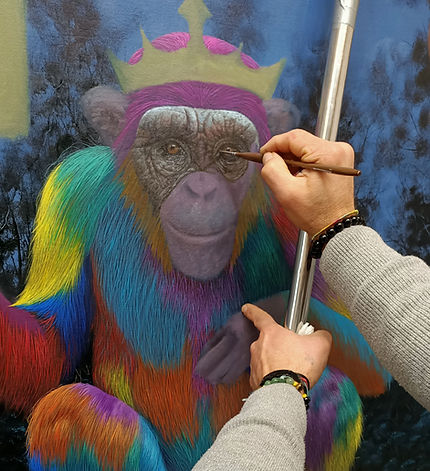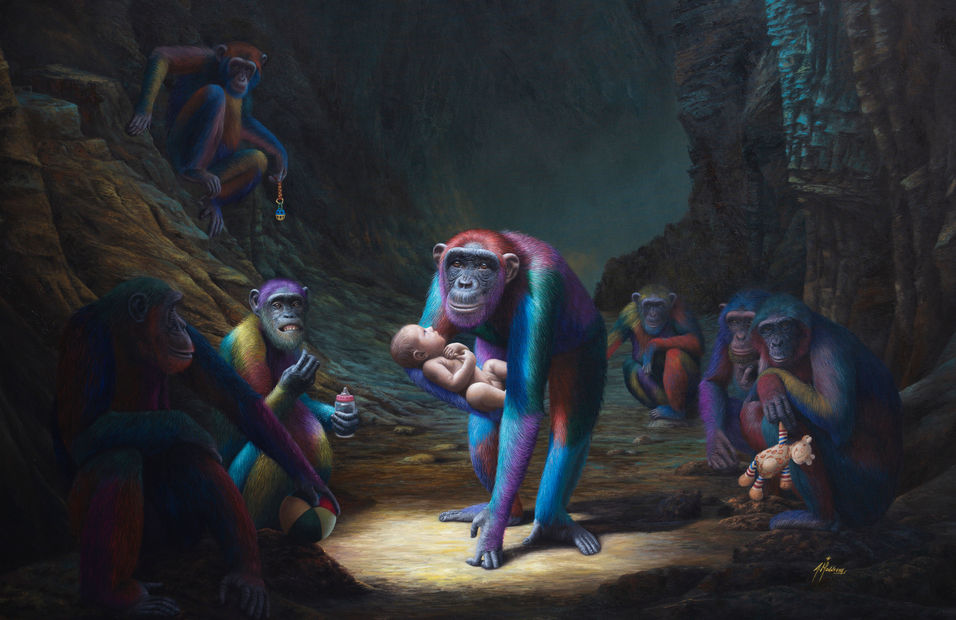ALEXANDRE MONNTOYA

THE IMPOSTOR'S WORLD
YOU WILL BE AND DO EVERYTHING I SAY
(UNTIL YOU REMEMBER WHAT YOU ARE)
The human being, whether consciously or unconsciously, is always searching for something that gives meaning to life. All of us, in different ways and along different paths, are seeking something we call “happiness.” And this is where self-awareness comes into play.
Without awareness of ourselves, we are condemned to live according to the standards of others. We are chained to seeing and living through appearances, overlooking what may truly be valuable.
We seek to be happy based on the opinions and visions of others, without ever asking ourselves what happiness really means to us, or what it is that truly makes us happy.

"I am an artist living in the body of a human."
Since childhood, alongside painting, I’ve been in love with human behavior—with its dramas and its joys. I’ve studied, observed, experienced, and consciously chosen to be an observer of my own Self.
And I’ve come to understand that what makes the difference between two people is the way each one sees and understands life. In other words, the outcome of one’s life depends on the level of consciousness each person possesses.
There are three fundamental questions that every human being has asked, or will ask, at some point in life.
Finding the answers to these three questions is the foundation of a conscious life—and therefore, a path that can lead us to that longed-for “Happiness.”
And these questions are:
Who am I? Where do I come from? Where am I going?

"I have studied, observed, experienced, and consciously sought to become an observer of my own Self."
"Being an artist doesn’t simply mean having talent—being an artist is the ability to see what others cannot see."
With this project called “The Impostor's World” I seek to share my point of view and hopefully contribute to answering these three fundamental questions.
Each of us, in moments of solitude or introspection, has likely recognized the duality between our thoughts and emotions. And in those moments—however brief—they have also led us to sense that we might be something more than just a body walking this Earth.
And although more and more people today are beginning to accept that we are something else in essence, most still do not understand why we are here.
Why don’t we remember anything?
What is this thing we call the “Ego”?
And why is it so difficult for us to take that path toward self-awareness and inner fulfillment?
And although “The Impostor's World” may carry references familiar to many from religious contexts, this project is by no means a religious one.
What it truly is, is a spiritual and psychological journey—with the intention of allowing the viewer to see themselves as the protagonist in each painting, and to gain a broader perspective of who they are, shedding light on the fundamental questions previously mentioned.
This project has a beginning, and I present it through three initial paintings.
One of its core characteristics is that it follows a chronological order—
It is, in essence, a story in which each painting is a chapter, and each chapter is a world.

THE VEIL
DETAIL


THE CONTRACT
DETAIL


THE ARRIVAL
DETAIL

The first chapter of this story is called “The Arrival,” and it invites us to reflect:
If we are something more than a body, then there must have been a moment when we chose to come to this plane of existence for the very first time.
And in that moment—at the moment of our arrival—something happened, or something was waiting for us.
Chapter Two: The Contract
In this painting, we encounter the character who will accompany us throughout our entire life.
And in order to access this planet—this world of the third dimension—we must agree to its rules, to its contract.
And the contract says:
“You will be and do everything I say... until you remember what you are.”
Chapter Three: The Veil
And after signing our contract, comes the moment when we are stripped of all our memories, our identity, our essence—
So that we may begin the path of self-discovery.


BIRTH
DETAIL

This is the point where everything begins to become visible, where the symbolic starts to take form.
The piece "Birth" functions as the threshold, the symbolic root, the moment before the "impostor" is activated.
Before imposture, there was tribe.
Before language, there was gesture.
Before the mask was formed, someone held the body with both hands.
This is the silent origin of the impostor.
A cave. A creature. A promise without words.
Here begins the fall into the human.
But also... its possibility of return.
PRELUDE
Never in my life as an artist have I felt as passionate about a project as I do about this one.
And a memory comes to mind—something a gallery owner once told me many years ago:
“A painter truly begins to paint after the age of 40.”
Now that I am over 50, I can say that beyond technique, I am finally able to be coherent with what I have lived, with what I know, with what I am, and with what I feel in every one of my paintings.



